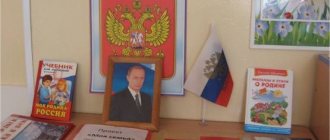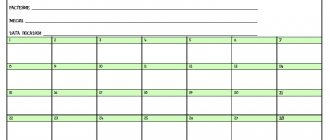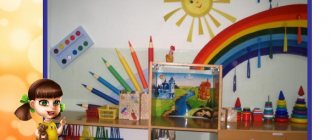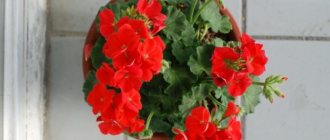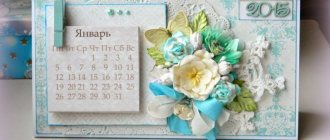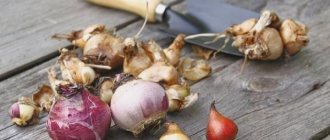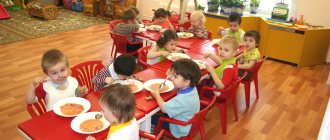What is important to consider when creating a natural corner in a kindergarten?
A living corner in a kindergarten is designed for each age group, taking into account sanitary standards, the age of the pupils and their capabilities.
SANPIN rules for preschool educational institutions 2.4.1.3049-13 clause 6.11. It has been established that placing animals, aquariums and birds in group rooms (dressing room, group room, bedroom, buffet, toilet) is not allowed.
Therefore, the main inhabitants of the corner will be plants: indoor flowers and a mini garden on the windowsill. The mini garden is made up of garlic, onions, oats and other crops grown in boxes in autumn and winter.
Requirements for the selection of plants
- Work in a corner of nature should be accessible to children in terms of time and strength, so plants are selected that are unpretentious in food and care.
- Plants should not be harmful to the health of children.
- Flowers for a corner of nature in a preschool educational institution should be selected from different types for comparison.
- When placing plants, you need to take into account their biological needs.
- The design of a corner of nature in a preschool educational institution must be done in such a way that preschool children can come up, observe, and do some work.
- Plants should have an attractive appearance that can attract and retain the unsteady attention of children.
The best corner of nature
Features of choosing indoor flowers for different groups
A corner of nature in the younger group should contain no more than 4-5 types of unpretentious indoor flowers. These are plants with distinct flowers, leaves and stems that bloom long and beautifully. Primrose, balsam, ficus, and geranium are perfect.
A corner of nature in the middle group should contain 5-6 species of plants. These are flowers with different sizes and shapes of leaves. In particular, agave, asparagus, chlorophytum.
In the corner of nature in the older group, 6 to 7 types of flowers are placed, 2 or 3 copies each. Plants must have different stems (creeping, climbing) and have bulbs or corms. These include ivy, tradescantia, amaryllis.
For the preparatory group, the number of plants is 6-7 species, which differ in the method of reproduction (bulbs, viviparous). For example, saxifrage, bryophyllum, cyperus.
When planning the design of a nature corner in a kindergarten, do not forget to provide a place to store work equipment, these could be:
- spray,
- watering can,
- cloths for wiping leaves,
- stick for loosening the soil,
- cups for seedlings.
In younger groups, the teacher monitors the cleanliness of the corner and instruments. In the senior and preparatory groups, this can be done with children (appoint a person on duty). The work of preschool children in a corner of nature is carried out in accordance with the curriculum.
Lessons in a corner of nature
Maria Skripnik works with children in the “Entertaining Zoology” and “In the Animal World” programs. During classes, the teacher tells the kids about animals, their diversity and role in nature. Children learn to care for pets, feed them, and monitor them. In addition to her classes, Maria is assigned to a zoo corner, where, as the manager and veterinarian, she monitors the health of animals, treats and cares for them, and conducts excursions for guests.
“The children and I also participate in events, holidays, promotions, conduct open classes such as “Bird Day”, “Pet Protection Day”, “Cat Day”, “Forest Day”, “Primroses”, “Feeder” campaigns, All-Russian lesson “Protected Islands of Russia”, we visit a pet store and a veterinary clinic. And in the VKontakte group “Zoo Corner” we post articles about the animal world, photos and videos of animals, classes and events of our organization,” says Maria.
Children at three to four years old and at five to six years old differ in the level of development of cognitive abilities. It’s enough for kids to simply watch fish and animals: the brighter they are, the easier it is for a child’s eye to catch on. With older children, you can grow plants from cuttings and seeds for a living corner, and study the habits of rodents and birds.
Natural corner in kindergarten: DIY decoration
When decorating a corner of nature in a preschool educational institution with your own hands, remember that it should contain a lot of visual material. The most significant of them is the nature calendar.
In a group for kids, it will be enough to place a picture depicting the current season. And also a doll dressed for the season.
For older children, there is a manual on the wall with pictures of the seasons and weather conditions with a moving arrow in the center. After the walk, you can discuss the weather with the children and move the arrow to the desired image. Also, in a corner of nature, it is necessary to set aside a place for children’s drawings on the topic of the observations made.
In older groups, children are introduced to symbols for indicating the weather. Every day, preschoolers mark weather fluctuations with conventional signs and at the end of the month they sum up the results: how many days were cloudy, how many sunny, windy, rainy. By the end of the year, the children will have an idea of the climate in their region.
A beautiful corner of nature in kindergarten
Often, a natural and ecological corner in a kindergarten is combined into one and, in addition to the above, the following is placed in it:
- a set of pictures with birds, insects, domestic and wild animals, plants;
- dummies of vegetables and fruits;
- children's crafts made from natural materials;
- equipment for conducting experiments - molds, containers of different volumes, spatulas, measuring spoons. You can conduct didactic games and experiments with water, sand, stones, shells, and clay to study their properties.
Activities in a corner of nature contribute to the development of work skills in preschool children. Already in the younger group, the teacher involves children in carrying out feasible work assignments. In the older group, corner duty is introduced.
Working in a corner of nature gives children a lot of pleasant experiences. Preschoolers learn to understand the world around them, to notice both general and individual signs of natural objects, which leads them to an understanding of the uniqueness and diversity of living organisms. Communication with nature stimulates children's thirst for creativity. A properly organized living corner is a powerful educational tool in the aesthetic, psychological and moral development of children.
Presentation for the competition. Best stand (corner) “Ecolyata-Preschoolers” project (middle group)
Slide 1
Branch of MBDOU "Kindergarten No. 43" - "Kindergarten No. 40", building 2 Presentation for the competition Best stand (corner) "Ecolyats - Preschoolers" Prepared by teachers: Keller V.S. Kovaleva S.T.
Slide 2
The information and educational stand “Ecolyats - preschool children” was created by teachers of the middle group of the branch of MBDOU “Kindergarten No. 43” - “Kindergarten No. 40”, building 2 Keller V.S., Kovaleva S.T., with the aim of forming a preschool education in children age of ecological culture and culture of love for nature. And also for a visual and information-effective familiarization of preschool children and parents with nature within the framework of the project: “Ekolyata”
Slide 4
The main goal of this stand is to educate preschoolers about an ecological culture, a caring attitude towards their native nature, its flora and fauna, as well as to teach children to care about the environment and be aware of the consequences of their actions in relation to it. This stand helps: to understand the inextricable connection between man and nature, its value for humans; to form a culture of love for nature in children; the child will understand the importance of preserving, protecting and saving nature for the survival of humanity on earth; broaden their general horizons and promote the development of children's creative abilities. To acquaint parents with the work carried out with children within the framework of the project: “Ekolyata” and advise them on the issues of instilling a caring attitude towards the environment.
Slide 5
The stand “Ekolyata – Preschool Children” is located in the reception room. This stand has 5 large and 2 small pockets, which allow you to place bright, interesting, informational and educational material in a single format for both parents and children. The stand is decorated in an ecological style, accompanied by bright, positive fairy-tale characters “Ecolyats - friends and defenders of nature” (Quiet, Herringbone, Naughty, Clever).
Slide 6
At the top of the stand is the logo “Ekolyata – Preschool Children” with the motto: “Only together, only in harmony, we need to help nature!” At the bottom of the stand there is a folder containing the creative works of our children.
Slide 7
The main part of the information stand, which is represented by “pockets,” contains educational material of a different nature, which is divided into functional sections: 1. Seasons In this section, we introduce children to the seasons, their signs and characteristics; with flora and fauna, how it changes depending on the time of year.
Slide 8
2. This is interesting. This section is dedicated to the project: “Ekolyata”, where children learn something new and interesting. During the year, interesting educational games about the animal and plant world were held with the pupils; conversations about caring for nature; monitoring the growth of onions, flowers, and the growth of tomato seedlings; experiments and experiments with water, snow, seeds. Experiments with seeds Experiments with snow Experiments with tomatoes
Slide 9
As part of this project, a creative workshop was created where children were engaged in creativity; environmental campaigns were carried out: “Bird Feeder”, “Wintering Birds Day”; environmental raids “Ekolyat” on the territory of the kindergarten; Research was conducted on the topic: “Onions for seven ailments.” Environmental campaigns: “Bird Feeder” “Bow for Seven Ailments.”
Slide 10
3. Card index Smart girl knows a lot and introduces children to environmental games, fairy tales, proverbs, sayings, riddles about nature, and indoor plants.
Slide 11
4. Information for parents. The beginning of environmental education is laid in the family, so material on ecology is selected for parents: consultations, recommendations, booklets..... Parents have the opportunity to get acquainted with information of an educational and educational nature using fairy-tale characters “ECOLYAT”.
Slide 12
5. Come visit nature. This section is presented with photographs that will tell how children help nature, do good deeds, and observe.
Slide 13
6. Eco-news. In this section we talk about the results of the project: “Ekolyata”, about the experiments and experiments being carried out, about where they went, where they participated.
Slide 14
In our group, we use the “Ecolyata - Preschoolers” stand for organizing educational activities, creative competitions, environmental events, cleanup days... This stand helps in working with both children and parents. It is a unique opportunity for children to discover, study and learn to protect nature, and for parents a way to become familiar with the results of work carried out on environmental education. The “Eco-Friends” depicted on the stand help to introduce children to the nature around them and use them in dramatizations and play them out in various environmental situations. Introduce parents to eco-news. All this allows you to make the educational process more interesting, and the proposed material more easily digestible.
Slide 15
Every reasonable person understands that he is part of the nature that surrounds him. Kindness makes us responsive and tolerant, capable of giving care and love to others. Love for nature is creation. It helps a person become kinder, more honest, and more responsible. Earth is our planet. Silver spruce trees, chamomile meadows, the hubbub of birds, clear water of rivers and lakes - this is all for us. And nearby there is a broken tree, trampled flowers, a dead frog, a ruined anthill - little things, it seems. But in reality, this is a terrible misfortune, this is a catastrophe. Every day one species of animal disappears on earth, every week we lose one species of plant forever. 20 hectares of tropical forests are cut down per minute. An ecological catastrophe looms over our planet, over everyone living on it.
Slide 16
Thank you for your attention!
Natural corner in kindergarten (photo)
Which animals to choose
“In our living area there are mainly unpretentious pets: Syrian and Djungarian hamsters, rats, gerbil mice, akomis spiny mice, rabbits, guinea pigs, budgies, and fish,” says Maria Skripnik. “But there are also those who need to create special conditions for a full life: Central Asian and red-eared turtles, chinchillas, degus, Achatina snails.”
Who can be accommodated in a zoo corner?
Fish
It is useful to choose fish of different breeds so that children can compare them and find differences. The most unpretentious breeds are considered to be guppies, swordtails, barbs, cardinals, zebrafish, catfish, and goldfish. It is better to place the aquarium in a cool, dark place away from the window.
Some types of fish cannot be kept in the same aquarium. For example, schooling barb fish do not get along well with smaller breeds (they simply eat them or bite off their fins), and also conflict with goldfish. The best neighbors for them will be swordtails, zebrafish, and parrotfish.
In addition, it is necessary to take into account the purity, hardness and acidity of the water. Guppies cannot stand dirt in an aquarium, so they do not get along well with goldfish. You should find out about all this in advance from a consultant at a pet store and read in specialized literature.
Reptiles
An interesting exhibit is a chameleon. By watching him, children learn about the phenomenon of mimicry. Land and waterfowl turtles will take root in the zoo corner.
“But turtles require a large aquarium or cage, an ultraviolet lamp for heating, and special food,” warns Maria Skripnik.
Waterfowl require an aquarium with rocks. Moreover, some of the stones should be located above the water so that the turtles can crawl onto land and bask under the lamp.
Rodents
It is allowed to keep rabbits, guinea pigs, mice, rats, and hamsters in the zoo corner of a preschool institution. Maria Skripnik says that each type has its own characteristics of content:
“For rabbits, rats, and guinea pigs, you have to clean the cage often and feed a lot. But spiny mice do not require frequent changes of bedding, they drink little, are unpretentious in food, but they love to live in the company of their relatives. Hamsters, on the contrary, prefer to live alone. They don't need a large cage, they don't eat much, and they're easy to care for. Some animals (hamsters, chinchillas, rats, Achatina snails) are more active at night and sleep during the day - it’s more interesting to watch them in the evening.”
If rodents live in cages, then they should be placed at a short distance so that the inhabitants of neighboring cages cannot injure each other. If animals are kept in aquariums, there is no such need.
Living corner in MBU DO "CD (Yu)TT" Salavat
Birds
Usually the zoo's corner is home to budgies, canaries, rosellas, cockatiels, and greenfinches. They are easy to care for, have bright colors and are popular with children. In addition, some species breed in captivity, which means kids will be able to watch the emergence and growth of chicks. There are species of parrots that exhibit strong sexual dimorphism—the difference in appearance between males and females. This is also a topic for class.
Plants
Plants can be conveniently divided into climatic zones. For example, imagine the tropical zone with ficus, chamedorea. The desert - aloe and other succulents, the subtropics - azaleas and geraniums.
During classes in the zoo corner, the child is involved in various types of activities: play, work, observation, discussion. This promotes comprehensive, diversified development. A living corner will give preschoolers extensive knowledge about nature and instill a love for the world around them. Getting acquainted with living nature, the child will develop morally, spiritually and aesthetically.
